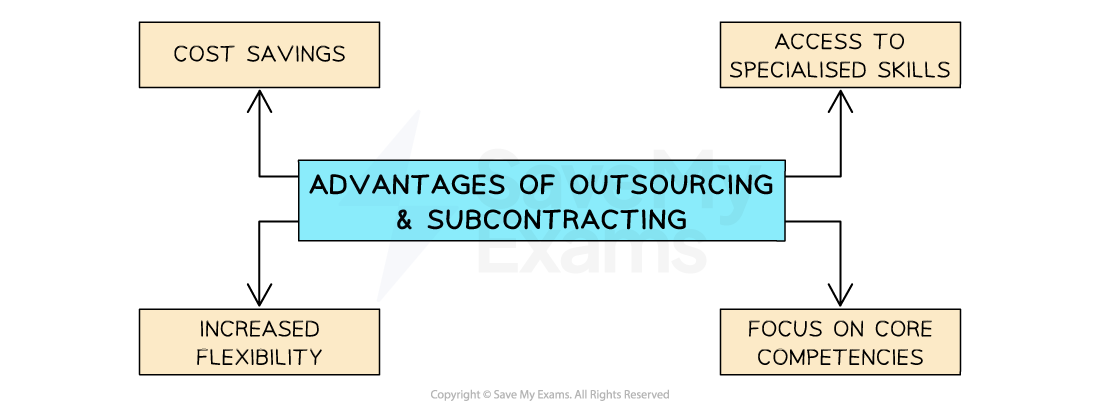Matching Supply and Demand (AQA A Level Business): Revision Note
Exam code: 7132
Why match supply and demand?
Managing supply to match demand means ensuring a business has just the right amount of resources, products or staff available to meet customer needs
Getting this right is vital for operational efficiency and customer satisfaction
If supply exceeds demand, the business may waste money on storage or unsold goods
If supply falls short, customers may face delays or go elsewhere
Businesses can use several methods to match supply to demand, such as:
outsourcing
hiring temporary or part-time staff
producing to order
Each option offers benefits and trade-offs — explored in more detail below
Outsourcing
Outsourcing is the process where a business delegates specific business activities, such as IT, customer support or HR, to external service providers
Businesses choose to outsource these functions to reduce costs, access specialised expertise or focus on core competencies
Subcontracting occurs when specific parts of a larger project or contract are assigned to third parties
The business remains responsible for the overall project or contract
Certain components or tasks are delegated to other companies or individuals with specialised skills
Advantages of outsourcing and subcontracting

Cost savings
Businesses can often reduce expenses such as hiring and training employees, maintaining facilities and managing IT systems
Access to specialised skills
External specialists have resources that a business may lack
This allows the business to benefit from the knowledge and experience of industry specialists as and when required
Increased flexibility
Businesses can provide greater flexibility to scale their operations up or down based on demand fluctuations
This is particularly valuable in industries with seasonal or unpredictable demand
Focus on core competencies
Businesses can concentrate their resources and efforts on their core competencies where they can add value
Limitations of outsourcing and subcontracting
Quality control
Using external providers makes it harder to ensure consistent quality and adherence to company standards
Loss of control
Handing direct control over those activities to others outside of the business may be risky
Companies must carefully select reliable outsourcing partners and establish clear expectations to protect their interests
Data security and confidentiality
Sharing sensitive information outside of the business introduces potential risks to data security and confidentiality
Communication and cultural differences
Using global providers may result in language barriers or problems with time zone differences
Using temporary and part-time employees
Flexible working is the development of a culture where workers are equipped to do different roles or work in a range of employment patterns
Examples include temporary or part-time contracts, flexible hours and working from home
Examples of flexible employment
Approach | Explanation |
|---|---|
Part-time contracts |
|
Temporary (fixed-term or seasonal) contracts |
|
Working from home / remote work |
|
Flexible hours |
|
Benefits of flexible employment
Ability to attract and retain good staff
Giving staff options such as flexitime or part-time hours makes the job fit their lives, so fewer staff leave and more applicants apply
Higher productivity and well-being
When employees can choose where or when they work, many focus better and feel less stressed, and output often rises
E.g. Atom Bank’s four-day-week trial saw staff complete the same work in fewer hours while customer service scores went up
Lower overhead costs for the business
Hybrid or home working means firms can reduce the size of offices, use fewer desks and cut rent and energy bills
Challenges of flexible employment
Communication and collaboration can suffer
When staff work on-screen instead of sharing the same physical space, informal chats and quick problem-solving decline
A recent UK survey (opens in a new tab)found that 55% of remote workers suffer video-call fatigue and lower team energy than their in-office counterparts
Equipping home offices costs money
Businesses must buy or reimburse staff for laptops, monitors and ergonomic chairs
Less face-to-face time can slow innovation
Remote teams are less likely to generate ideas than on-site groups or workers because spontaneous brainstorming drops with remote work
Need for monitoring to keep everyone on task
Many UK companies now install time-tracking or screen-monitoring software to check remote productivity, raising privacy concerns and extra work for managers
Producing to order
Producing to order is when a product is built only after a customer confirms an order, rather than being made for stock
The customer’s exact choices, such as size, style, colour and features, drive production, so nothing is finished in advance
Examples of products often made to order

Evaluating producing to order
Advantages | Disadvantages |
|---|---|
|
|
|
|
|
|
|
|

Unlock more, it's free!
Did this page help you?